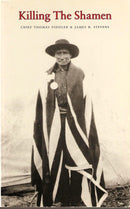Description
Killing the Shamen is the story of the Sandy Lake Cree of northwestern Ontario and their clash with the Canadian criminal justice system in 1907. Jack Fiddler, shaman and leader, together with his brother, Joseph Fiddler, were charged with murder in the death of a possessed woman who had become a windigo. The two men were taken to Norway House in Manitoba for trial. This compelling story is told through the words of several Cree Elders who in 1971 began a search for the truth with the author, James R. Stevens. Stevens begins the book with background about the Sucker clan leader, Porcupine Standing Sideways, the father of Jack and Joseph Fiddler. Stevens utilizes archival records from the Hudson Bay Company, newspaper articles, and documents from the Public Archives of Canada to piece together the story of the arrest, court case, and the aftermath of the event. Three years after the trial, the Canadian government began treaty negotiations with the Cree of northern Ontario. The striking oral testimony of Chief Thomas Fiddler (grandson of Joseph), Thomas Linklater, Edward Rae, Thomas Fiddler, William Mamakeesick, Abraham Mamakeesick, Jeremiah Sainnawap, Abel Fiddler, and Ateyen Kakagamick recount what it is like to live as a hunting people in the North. Their stories explain their worldview, the power of Shamen, the role of dreams and visions, traditional healing, and the impact of Euro-western religion and economy. Stevens portrays the racism of the police and media that influenced the jury and public opinion during the trial. The oral histories from contemporary Cree Elders allow the reader to understand the First Nation's viewpoint. This is an important account about a little-known fact in Canadian history.


